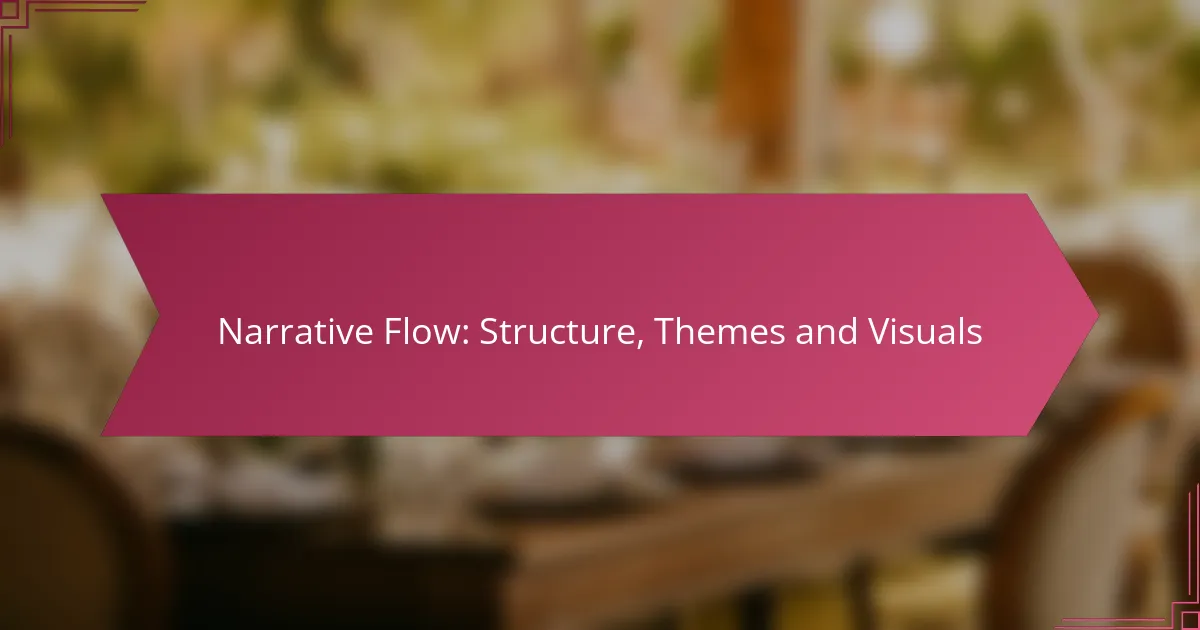Narrative flow is essential for crafting engaging stories that resonate with audiences. By structuring a narrative thoughtfully, incorporating meaningful themes, and utilizing visuals, storytellers can enhance clarity and emotional depth, guiding readers through the intricacies of plot and character development. This cohesive approach not only captivates but also enriches the overall storytelling experience.
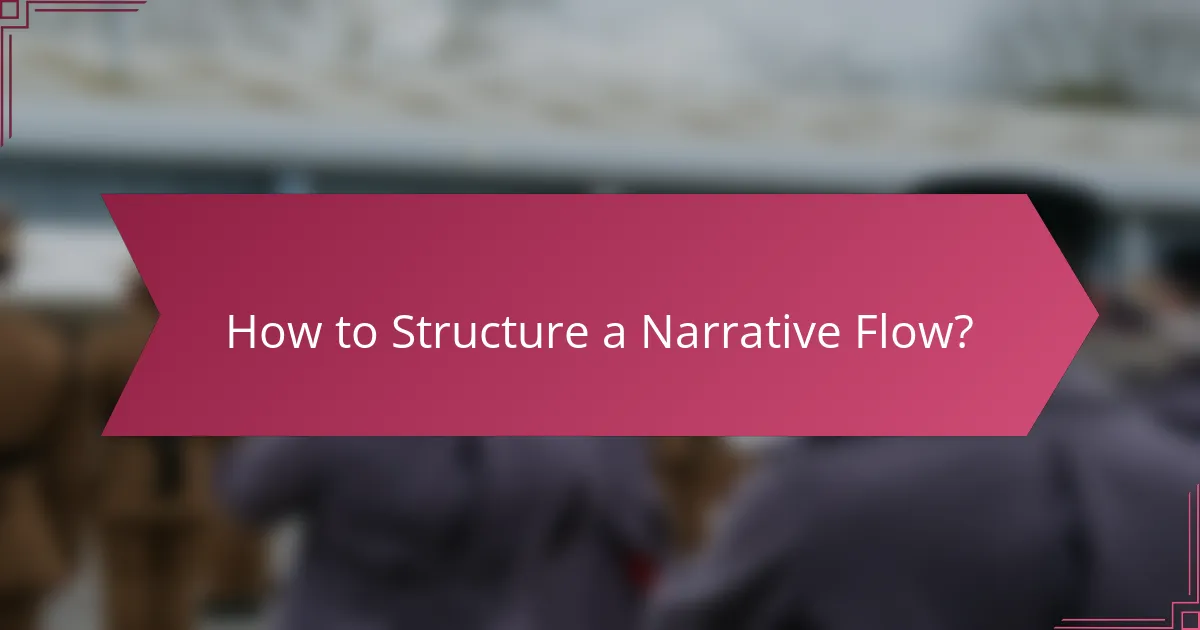
How to Structure a Narrative Flow?
Structuring a narrative flow involves organizing a story in a way that engages the audience and conveys the intended message effectively. A well-structured narrative enhances clarity and emotional impact, guiding readers through the plot and character development seamlessly.
Beginning, Middle, End Framework
The Beginning, Middle, End framework is a fundamental structure for storytelling. The beginning introduces characters and sets the scene, the middle develops the plot with conflicts and challenges, and the end resolves these conflicts, providing closure. This simple yet effective structure helps maintain a clear narrative direction.
When crafting your narrative, ensure that each section transitions smoothly into the next. For example, a strong opening can hook the audience, while a satisfying conclusion can leave a lasting impression. Aim for a balanced distribution of content across these three parts to maintain engagement.
Three-Act Structure
The Three-Act Structure divides a narrative into three distinct sections: Setup, Confrontation, and Resolution. In the Setup, characters and settings are introduced, while the Confrontation escalates the central conflict, leading to a climax. Finally, the Resolution ties up loose ends and resolves the story’s main issues.
This structure is popular in screenwriting and can be adapted for various narrative forms. To implement it effectively, identify key plot points for each act and ensure that the stakes rise throughout the story, keeping the audience invested in the outcome.
Freytag’s Pyramid
Freytag’s Pyramid is a model that outlines the five key elements of a narrative: Exposition, Rising Action, Climax, Falling Action, and Denouement. This structure emphasizes the importance of building tension and conflict before reaching a peak, followed by a resolution that provides closure.
Utilizing Freytag’s Pyramid can help writers visualize the flow of their story. For instance, the Rising Action should introduce complications that lead to the Climax, while the Falling Action should begin to resolve these complications, guiding the audience toward the Denouement.
Linear vs. Non-linear Narratives
Linear narratives follow a straightforward chronological order, making it easy for the audience to follow the plot. Non-linear narratives, on the other hand, may jump between timelines or perspectives, creating complexity and intrigue. Each approach has its advantages, depending on the story being told.
When choosing between linear and non-linear structures, consider the emotional impact you want to achieve. Linear narratives are often more accessible, while non-linear narratives can create suspense or surprise. Ensure that transitions are clear to avoid confusing the audience.
Character Arcs and Plot Development
Character arcs are essential for driving plot development and engaging the audience. A well-defined character arc shows how a character evolves throughout the story, often in response to the challenges they face. This growth can enhance the emotional depth of the narrative.
To create compelling character arcs, identify the character’s starting point, their goals, and the obstacles they must overcome. Ensure that their journey aligns with the plot’s progression, allowing for moments of conflict and resolution that resonate with the audience.
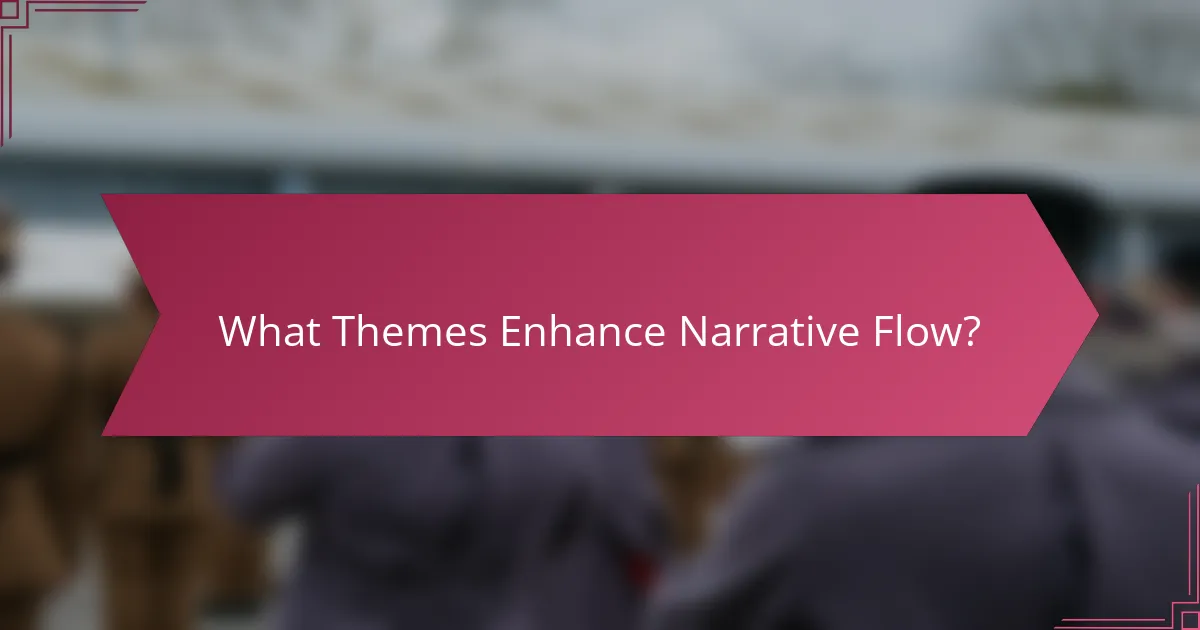
What Themes Enhance Narrative Flow?
Themes play a crucial role in enhancing narrative flow by providing depth and coherence to the story. They connect characters and events, guiding the audience through the narrative while evoking emotions and reflections.
Universal Themes
Universal themes resonate across diverse cultures and time periods, making them relatable to a wide audience. Examples include love, loss, and the quest for identity, which can evoke strong emotional responses and foster connections between the audience and the narrative.
Incorporating universal themes can strengthen the narrative by allowing readers to see their own experiences reflected in the story. This connection can enhance engagement and make the narrative more impactful.
Character vs. Society
The theme of character versus society explores the struggles individuals face against societal norms and expectations. This conflict often drives the plot and reveals the complexities of human behavior and social structures.
Writers can illustrate this theme through characters who challenge societal conventions or who are marginalized by their communities. This not only adds tension to the narrative but also prompts readers to reflect on their own societal values and beliefs.
Conflict and Resolution
Conflict is essential for narrative flow, as it creates tension and propels the story forward. The resolution of these conflicts provides closure and can lead to character development and thematic exploration.
Effective narratives often present multiple layers of conflict, such as internal struggles within characters and external challenges from the environment or other characters. Balancing these conflicts and their resolutions can enhance the overall narrative structure.
Symbolism and Motifs
Symbolism and motifs enrich narratives by adding deeper meanings and connections throughout the story. Symbols can represent larger concepts, while motifs are recurring elements that reinforce themes.
For example, a recurring image of a storm might symbolize turmoil or change, while a character’s journey through a city can reflect their personal growth. Thoughtfully integrating these elements can create a more cohesive and engaging narrative experience.
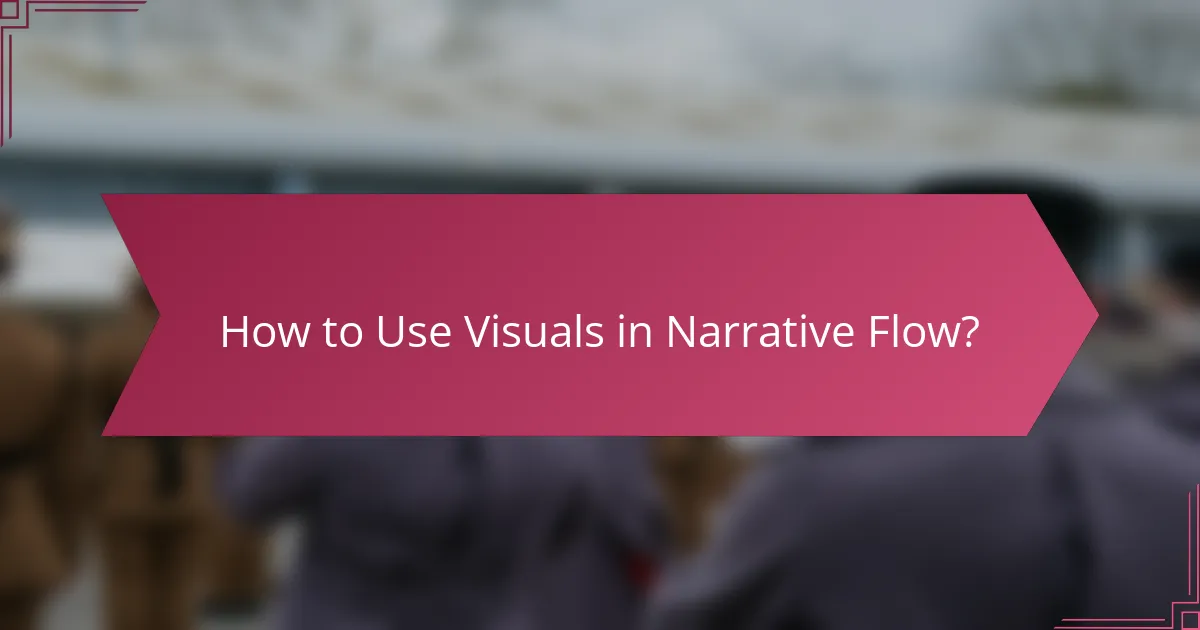
How to Use Visuals in Narrative Flow?
Using visuals effectively in narrative flow enhances storytelling by making complex ideas more accessible and engaging. Visuals can clarify themes, highlight key points, and maintain audience interest throughout the narrative.
Visual Storytelling Techniques
Visual storytelling techniques involve using images, videos, and graphics to convey a narrative. These techniques can include sequential imagery, animations, or interactive elements that guide the audience through the story. Consider using a mix of formats to cater to different learning styles and keep the narrative dynamic.
One effective method is the use of storyboards, which outline the visual progression of the narrative. This helps in planning how visuals will complement the text and ensures a cohesive flow. Remember to maintain a consistent style to reinforce the narrative’s tone.
Infographics and Data Visualization
Infographics and data visualization are powerful tools for presenting information clearly and concisely. They can transform complex data into easily digestible visuals, making it easier for the audience to grasp key insights. Use charts, graphs, and maps to illustrate trends or comparisons effectively.
When creating infographics, focus on clarity and simplicity. Limit the amount of text and use icons or symbols to represent data points. A well-designed infographic can enhance understanding and retention of information, making it a valuable addition to your narrative.
Illustrations and Photography
Illustrations and photography can evoke emotions and set the tone for a narrative. High-quality images can draw readers in, while illustrations can provide a unique perspective or style that aligns with the narrative’s theme. Choose visuals that resonate with the audience and enhance the story’s message.
Consider the context in which these visuals will be used. For example, illustrations may work better for whimsical or abstract narratives, while photography might be more suitable for realistic or documentary-style storytelling. Always ensure that visuals are relevant and contribute meaningfully to the narrative flow.
Color Theory in Narratives
Color theory plays a crucial role in how visuals are perceived and can significantly impact the narrative flow. Different colors evoke various emotions and associations, which can enhance or detract from the story being told. Use color strategically to reinforce themes and guide audience reactions.
For instance, warm colors like red and orange can create a sense of urgency or excitement, while cool colors like blue and green can evoke calmness or trust. Be mindful of cultural connotations of colors, as they can vary widely. A well-thought-out color palette can unify the visual elements and strengthen the overall narrative.
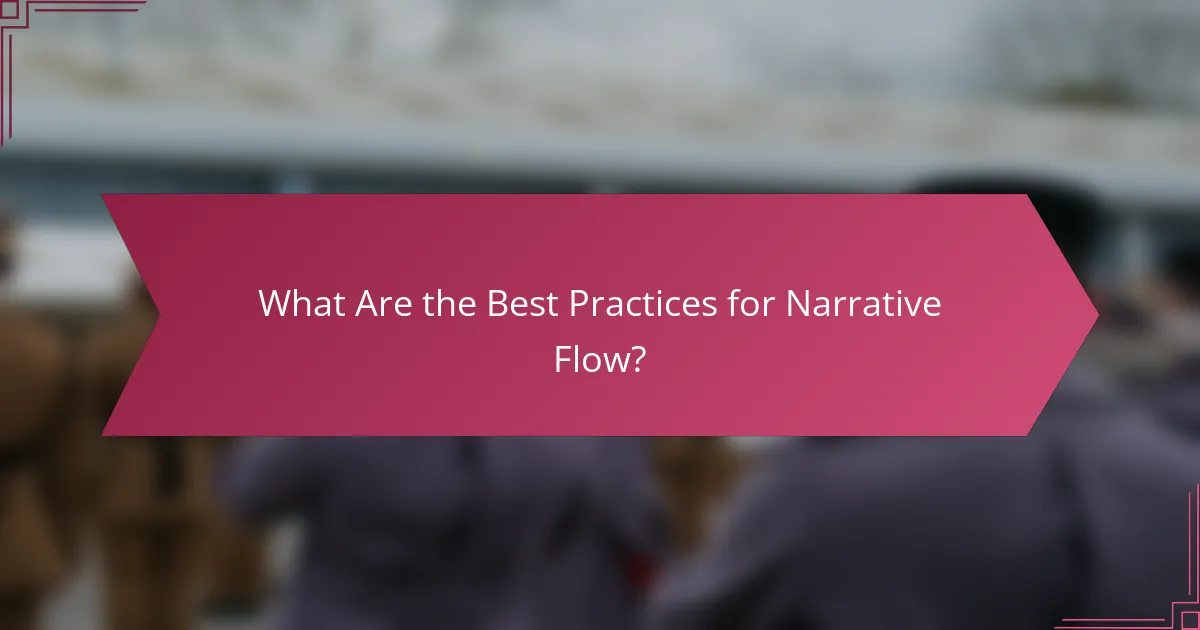
What Are the Best Practices for Narrative Flow?
Best practices for narrative flow involve maintaining a clear and engaging structure that guides the audience through the story. This includes consistency in tone, engaging the audience effectively, and incorporating feedback loops for refinement.
Consistency in Tone and Style
Maintaining consistency in tone and style is crucial for narrative flow. A unified voice helps to create a seamless experience for the audience, making it easier for them to connect with the content. For instance, if the narrative is light-hearted, it should remain so throughout, avoiding sudden shifts to a serious tone.
Consider using a style guide to ensure that language, terminology, and formatting remain consistent. This can include specific word choices, sentence structures, and even visual elements that align with the narrative’s theme.
Engaging the Audience
Engaging the audience is essential for keeping their interest and enhancing narrative flow. Techniques such as asking rhetorical questions, using relatable anecdotes, or incorporating interactive elements can draw readers in. For example, a story that invites the audience to reflect on their own experiences can create a stronger connection.
Utilizing visuals, such as images or infographics, can also enhance engagement by breaking up text and providing additional context. Aim for a balance between text and visuals to maintain a dynamic narrative pace.
Editing and Feedback Loops
Editing and feedback loops are vital for refining narrative flow. After drafting, revising the content with a focus on clarity and coherence can significantly improve the overall quality. Consider seeking feedback from peers or target audience members to identify areas that may need adjustment.
Establish a systematic approach to editing, such as reading the narrative aloud or using tools that highlight readability issues. This can help ensure that the narrative flows smoothly and resonates with the intended audience.
